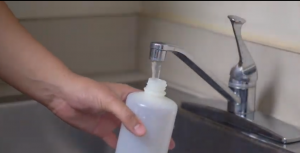 Childhood lead poisoning is considered the most preventable environmental disease among young children. Lead poisoning can negatively affect children’s intelligence, behavior, hearing, and development. The most common sources of elevated blood lead levels in Arizona are lead-based paint found in homes built before 1978, imported goods such as spices, makeups, and ceramic pottery, lead in dust and soil, as well as some parent occupations and hobbies. While ADHS has never identified drinking water as a cause of elevated blood lead levels in Arizona, we know that young children are the most susceptible to the effects of lead poisoning. Because of this, we embarked on a year-long project to conduct drinking water screening in child care facilities across the state.
Childhood lead poisoning is considered the most preventable environmental disease among young children. Lead poisoning can negatively affect children’s intelligence, behavior, hearing, and development. The most common sources of elevated blood lead levels in Arizona are lead-based paint found in homes built before 1978, imported goods such as spices, makeups, and ceramic pottery, lead in dust and soil, as well as some parent occupations and hobbies. While ADHS has never identified drinking water as a cause of elevated blood lead levels in Arizona, we know that young children are the most susceptible to the effects of lead poisoning. Because of this, we embarked on a year-long project to conduct drinking water screening in child care facilities across the state.
This child care drinking water screening project was designed to support our child care partners in promoting health and wellness for the children and families they serve. Our Child Care Licensing surveyors collected over 2,200 drinking water samples from drinking water sources at 1,055 facilities during the course of conducting facility inspections. While our Arizona State Public Health Laboratory identified that 4 of the 1,055 child care facilities had samples with lead concentrations above the Environmental Protection Agency’s action level of 15 parts per billion (ppb) during initial sampling, none were above the screening level after the drinking water fixture was flushed for two minutes. Read the full report here.
Our Childhood Lead Poisoning Prevention Program is ready to respond when children are identified with elevated blood lead levels. Every year, we review more than 65,000 blood lead test results received from laboratories and health care providers across the state to make sure children with elevated blood lead levels will receive proper care. When a child is identified with an elevated blood lead level, we coordinate with families and health care providers to identify the source of the lead poisoning through phone interviews and home investigations. We often collect paint, soil, dust, or other samples to pinpoint the source.
The only way to know if a child has been exposed to lead is through a blood lead test. Check your child’s full address on our lead risk map to view screening recommendations for your neighborhood and talk to your child’s doctor about a blood lead test.









